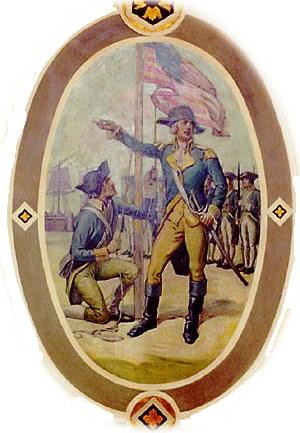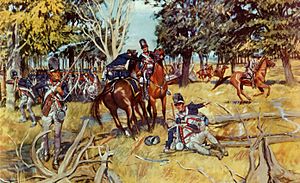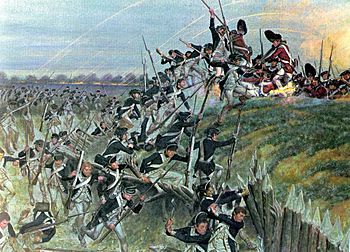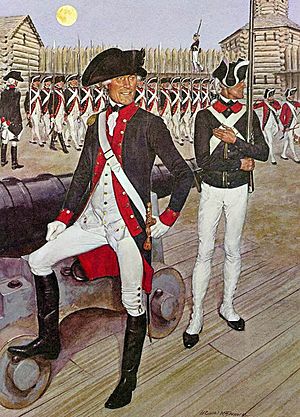Jean François Hamtramck facts for kids
Quick facts for kids
Jean François Hamtramck
|
|
|---|---|

Colonel Hamtramck taking possession of Fort Lernoult for the United States in 1796.
|
|
| Birth name | Jean-François Hamtramck |
| Other name(s) | John Francis Hamtramck |
| Born | 1756 Montreal, Canada |
| Died | 1803 (aged 46–47) Detroit, Michigan |
| Buried | |
| Allegiance | United States |
| Branch | Continental Army Legion of the United States United States Army |
| Years of service | 1776 - 1783, 1785 - 1803 |
| Rank | |
| Unit | 1st Infantry Regiment |
| Commands held | 1st Infantry Regiment |
| Battles/wars | American Revolutionary War Northwest Indian War |
| Spouse(s) | Marie Josèphe Edeline |
Jean-François Hamtramck (1756–1803) was a brave soldier who served as an officer in the US Army. He fought in two important wars: the American Revolutionary War and the Northwest Indian War. During the Revolution, he was part of big events like the invasion of Quebec and the Siege of Yorktown.
Hamtramck helped the United States expand into new lands, especially in the Midwest. He is linked to forts in places like Steubenville, Vincennes, Fort Wayne, and Detroit. The city of Hamtramck, Michigan is even named after him!
Contents
Early Life and Military Start
Jean-François Hamtramck was born in Montreal, Canada, which was then part of New France. His father was a barber from Germany, and his mother was Canadian. He was baptized in the Catholic Church in August 1756. Hamtramck was very good with languages. He could speak French, English, German, and Latin.
Fighting for Freedom: The American Revolution
Hamtramck joined the fight for American independence when he was just 19 years old.
Adventures in Canada
When American forces led by General Montgomery invaded Canada, Hamtramck joined the 1st Canadian Regiment. He helped get supplies for the soldiers. He was there when Fort Chambly was captured.
Later, he became a deputy commissary, helping to supply the whole Continental Army. The Americans lost the Battle of Quebec, and General Montgomery was killed. Hamtramck helped gather new soldiers and became a Captain. However, he was later made a Lieutenant, leading 10 French Canadians.
During the Battle of the Cedars, Hamtramck was captured by the British. He insisted on being treated like an officer. After being held on the Island of Montreal, he was abandoned by his captors. Hamtramck led his men on a tough four-day journey back to Montreal.
Because he would be seen as a traitor if captured again, Hamtramck traveled to the United States with the defeated American army. He told his story to a special committee in Philadelphia. The committee gave him money and recognized him as a Captain.
Serving in the United States
Battles in New York
Captain Hamtramck joined the 5th New York Regiment. He quickly became known as a strict leader, which earned him respect. In October, he bravely escaped from Fort Montgomery when the British took it over. He even used a broken musket to fight his way out!
After escaping, he helped reorganize and supply his company. In 1779, Hamtramck led his company in the Sullivan Expedition. He fought in the Battle of Newtown, helping another regiment. That winter, he camped with the army at Morristown.
Hamtramck's regiment later joined a new Division led by General Lafayette. They marched across New York and New Jersey. In October, they were sent to protect West Point after General Arnold's betrayal was discovered.
Victory at Yorktown
In July, Hamtramck's company joined a special light infantry group led by Lieutenant Colonel Alexander Hamilton. They marched to the Siege of Yorktown, a very important battle. Hamtramck's company was the first to dig trenches close to the British defenses. He also led his company in a daring attack on Redoubt 10, a British fort.
After the victory at Yorktown, Hamtramck's company returned north, escorting prisoners. They spent the winter in New Jersey, not knowing the war was almost over for them. General George Washington himself complimented Hamtramck on a plan he suggested.
Hamtramck left the army on June 3, 1783. He was promoted to Major when he left. He couldn't go back to Canada, so he stayed in the United States.
Protecting the Frontier: The Northwest Indian War
The First American Regiment
In 1785, Hamtramck rejoined the army as a Captain in the First American Regiment. This was the only standing army left after the Revolution. In 1786, he was sent to protect land surveyors and remove illegal settlers in Ohio. He was promoted to Major that October.
Hamtramck built Fort Steuben in Ohio. He even made his soldiers compete to build parts of the fort, offering whiskey to the winners! This fort later became the city of Steubenville, Ohio.
Commanding at Vincennes
In 1787, Major Hamtramck went to Vincennes. He was left in command of 95 soldiers at Fort Patrick Henry. He built a new fort there, which was named Fort Knox.
In 1788, some Kentucky militia arrived in Vincennes, wanting to attack Native Americans. Hamtramck told them to leave, saying the peaceful tribes were "under the protection of the United States." He worried that these raids would cause more trouble.
Because there were not many U.S. officials, Hamtramck became the main government representative in Vincennes. He spoke both French and English, which helped him work well with both American settlers and French-speaking residents. He was also popular because he was Catholic.
Hamtramck stayed at Vincennes until 1791. He successfully helped stop fighting between the local Native American groups and Vincennes. He even helped a soldier named William Wells reconnect with his family.
The 1790 Campaign
In 1790, Hamtramck married Marie Josèphe Edeline in Vincennes. They had three daughters.
That autumn, Major Hamtramck was ordered to attack Native American villages to distract from a larger campaign. His force had about 300 men. They reached an empty village, but many of his soldiers left. Hamtramck decided to return to Vincennes, knowing a much larger Native American force was waiting. Even though he thought his mission failed, he later learned that his actions had successfully distracted the enemy.
St. Clair's Defeat and Aftermath

In 1791, Hamtramck was put in charge of the First American Regiment. They were part of a new campaign led by General Arthur St. Clair. Hamtramck helped build Fort Hamilton.
Later, Hamtramck's regiment was ordered to protect supply trains. They heard cannon fire and rushed to help. They met fleeing soldiers who said the army was destroyed in St. Clair's Defeat. Hamtramck secured Fort Jefferson. He was later criticized for not reaching the main army sooner, but he was found innocent after an investigation.
Hamtramck returned to Vincennes in 1792 and helped make peace with local Native American groups.
The Legion of the United States
In 1793, Hamtramck was promoted to Lieutenant Colonel Commandant. He joined the Legion of the United States, led by General Anthony Wayne. This Legion was formed to secure the Northwest Territory.
Hamtramck was put in command of Fort Jefferson in 1793. When General Wayne's army approached the fort, they heard gunshots. They thought the fort was under attack, but it was just Hamtramck training his soldiers in a mock battle!
At the Battle of Fallen Timbers in 1794, Hamtramck commanded a large part of the Legion. The American victory at this battle was very important. It led to the Treaty of Greenville, which opened up much of modern Ohio for American settlement.
Later Military Career
After the Battle of Fallen Timbers, Hamtramck became the first commander of Fort Wayne. He even owned a large farm there with his friend, William Wells. In 1796, he secured Fort Maumee. He was then transferred to Fort Lernoult (later called Fort Shelby) in Detroit on July 11, 1796.
In 1798, Hamtramck was given command of the military headquarters in the Northwest. He was later transferred to Fort Adams, Mississippi in the Southwest. On April 1, 1801, he was promoted to Colonel and sent back to Detroit.
Colonel Hamtramck remained in command at Detroit. He lived in a house near where the bridge to Belle Isle is today.
Death and Burial
Colonel Hamtramck died on April 11, 1803. He was buried at Ste. Anne de Detroit Catholic Church. The officers who served under him placed a stone to honor him. His body was moved several times and finally laid to rest in 1962 at Veterans Park in Hamtramck, Michigan.
Military Ranks
- Commissary, 1st Canadian Regiment - September 15, 1775
 Lieutenant, 2nd Canadian Regiment - 1776 (Congress later recognized him as a Captain)
Lieutenant, 2nd Canadian Regiment - 1776 (Congress later recognized him as a Captain) Captain, 5th New York Regiment - November 21, 1776
Captain, 5th New York Regiment - November 21, 1776 Captain, 2nd New York Regiment - January 1, 1783
Captain, 2nd New York Regiment - January 1, 1783- Discharged - June 3, 1783
 Captain, US Infantry Regiment - April 12, 1785
Captain, US Infantry Regiment - April 12, 1785 Major, US Infantry Regiment - October 20, 1786
Major, US Infantry Regiment - October 20, 1786 Major, 1st Infantry Regiment - September 29, 1789
Major, 1st Infantry Regiment - September 29, 1789 Major, 2nd Sub-legion - September 4, 1792
Major, 2nd Sub-legion - September 4, 1792 Lieutenant Colonel Commandant, 1st Sub-legion - February 18, 1793
Lieutenant Colonel Commandant, 1st Sub-legion - February 18, 1793 Lieutenant Colonel Commandant, 1st Infantry - November 1, 1796
Lieutenant Colonel Commandant, 1st Infantry - November 1, 1796 Colonel, 1st Infantry - April 1, 1802
Colonel, 1st Infantry - April 1, 1802
Hamtramck's Lasting Legacy
In 1827, a part of Wayne County, Michigan was named Hamtramck Township in his honor. A portion of this township later became the city of Hamtramck, Michigan.
Hamtramck's son, also named John Francis Hamtramck, followed in his father's footsteps. He attended the United States Military Academy and became a Colonel, serving in the Mexican–American War.
In 1962, Colonel Hamtramck's remains were moved to the city of Hamtramck, Michigan. His grave is now part of the Veterans Memorial at the entrance to Veterans Memorial Park. This park is the main city park in Hamtramck.
His grave site is a Michigan historical marker. The words on his grave marker say:
- Colonel John Francis Hamtramck, Esq.
- The First United States Regiment of Infantry and Commandant of Detroit and its dependencies.
- He departed this life on the 11th of April 1803 aged 48 years, 7 months and 28 days.
- True patriotism and zealous attachment to national liberty joined to a laudable ambition led him into military service at an early period of his life.
- He was a soldier even before he was a man. He was an active participant in all the dangers, difficulties and honors of the revolutionary war, and his heroism and uniform good conduct procured him the attention and personal thanks of the immortal Washington.
- The United States in him have lost a valuable officer and a good citizen, and society a useful and pleasant member.
- To his family his loss is incalculable, and his friends never forget the memory of Hamtramck. This humble monument is placed over his remains by the officers who had the honor to serve under his command- A small but grateful tribute to his merit and his worth.
- This inscription was restored by the Catholic Study Club of Detroit, Michigan May 30th 1928.



